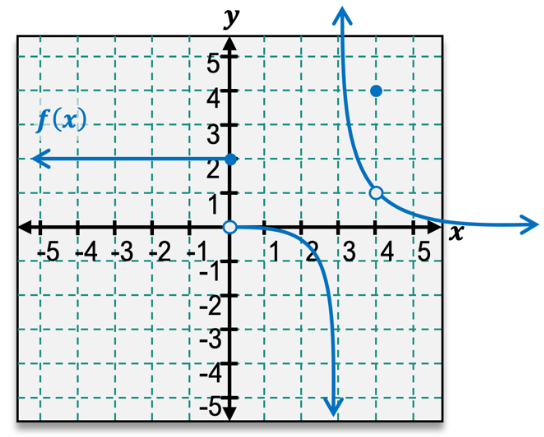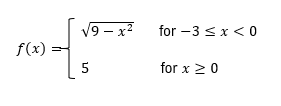Hey, everyone. In this problem, we're asked to determine the values of x, if any, for which this function is discontinuous. Now, since the function that we're given here is a piecewise function, that means that we want to look at the x values between each piece. So let's go ahead and get started here. Now looking at our first two pieces, the x value between these two pieces is x equals negative 2.
That's where we transition from our first piece to our second piece. That means that we want to explore x equals negative 2 and see if our limits and our function value are the same because if they are, then our function is continuous there. But if not, then we know we have a discontinuity. So let's go ahead and do that. Looking at x equals negative 2, we're first going to take a look at our limit, so the limit of f of x as x approaches negative 2.
Now, because this is a piecewise function, that means that we need to make sure that we look at our limit coming in from the left and from the right in order to accurately determine our limit. So here, we want to split this into our one-sided limits to see if these are the same. So looking at our left sided limit first, the limit of f of x as x approaches negative 2 from the left. Looking up at my function here as we approach negative 2 from the left, I know that my function value is just going to be 5. So this is my left sided limit.
It's just 5. Now, for our right sided limit, the limit of f of x as x approaches negative 2 from the right. Looking back up at my piecewise function, I know that coming in from the right side, my function is going to be x2 + 2x + 1. So I need to go ahead and plug a negative 2 into this function in order to look at my right sided limit. So plugging that in, I have (-2)2 + 2×(-2) + 1.
Now this ends up giving me 4 - 4 + 1. Those fours cancel each other out. So my right sided limit is 1. Now here, my left sided limit is 5. My right sided limit is 1.
These are not the same value, which means that my regular limit, the limit of f of x as x approaches a negative 2, actually does not exist. Now because we already know that our limit does not exist here, this definitely won't be equal to our function value f of negative 2. So we really don't even have to worry about finding that. But let's go ahead and find it just to cover all our bases. Now for f of negative 2, I know that my function is going to be equal to this quadratic function x2 + 2x + 1.
Now we actually already found what that is with our right sided limit, so I know that f of negative 2 is 1. Now if my limit does not exist, that is definitely not the same thing as being 1. So here, since our limit and our function value are not the same, we know for sure that we have a discontinuity at x equals negative 2. Now we do have another piece to our piecewise function, so we need to take a look at one other x value here. Now our other x value between these two pieces is x equals 0.
So let's go ahead and explore x equals 0 here. So for x equals 0, we want to look at the same stuff. We want to look at the limit and the function value. So let's start by taking a look at our limit. So we want to look at the limit of our function f of x as x approaches 0.
Now, again, here, we want to look at our one-sided limits. So we're going to start with our left sided limit, the limit of f of x as x approaches 0 from the left. Now coming in from that left side, my function is going to be equal to that same quadratic function, x2 + 2x + 1. So I can go ahead and plug 0 into that function in order to get my left sided limit. So plugging 0 in, I have 02 + 2×0 + 1.
Those first two terms end up being 0. So my left sided limit is just 1. Now let's look at our right sided limit, the limit of f of x as x approaches 0 from the right. Now coming in from the right side, my function is going to be equal to that last piece, x + 1.
So I want to go ahead and plug 0 in to get that right-side limit to my function x + 1. Now plugging that in, I have 0+1, which we know is just 1. So my left sided limit is 1. My right sided limit is also 1. Because these are the same value, that tells me that my limit, my regular limit of f of x as x approaches 0 is also 1.
So let's go ahead and check if this is equal to our function value. So we want to look at f of 0. Now f of 0, looking at my functions over here, is going to be equal to that same quadratic function, x2 + 2x + 1. So I want to plug 0 into that function, which we actually have already done in that left-sided limit. So I already know that this is equal to 1.
Now because my limit here is equal to my function value, then my function is actually continuous at x equals 0. And I don't have a discontinuity here. So the only discontinuity in this piecewise function, having tested both of those x values between my pieces, is going to be x equals negative 2. That is where this function is discontinuous. Now I know that was a rather long and tedious process.
Feel free to let me know if you have any questions here, and I'll see you in the next video.








